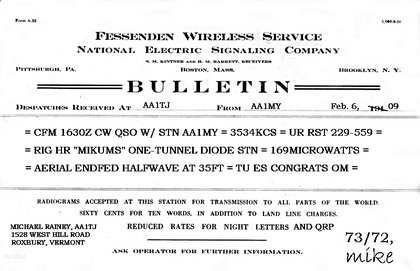First "skywave" QSO completed with AA1MY on 2/6/09!
(Please click on above QSL to enlarge)
It occurred to me that the keying technique used in my Reggie transceiver would provide an excellent solution to the problem of keying a tunnel diode transmitter. The result is Mikums; a one-active-device, 80m, CW, transceiver built around a single tunnel diode.
Mikums allows one to optimize the tunnel diode oscillator bias for maximum power production rather than for reliable oscillator keying. In this design a pair of 1N4007 diodes switch a continuously running oscillator between the (matched) receiver and transmitter loads. Thus, the oscillator remains entirely unaffected by the keying action; it keys like a dream!
The overall design follows the plan of Reggie quite closely. However, it was necessary to use Germanium diodes in the product detector on account of the lower-level BFO signal available. The receiver works well. In fact, the first signal copied with this receiver happened to be a Cuban station calling CQ on the low-end of 80m; an auspicious beginning!
Even moreso than in my Reggie setup, the receiver used in Mikums bears a resemblance to Reginald Fessenden's heterodyne receiver (Figure 8 of this document) used aboard the USS Salem during the receiving trials of 1912-1913 (please refer to my page on Reggie for more details). I say this, inasmuch as Fessenden employed a negative resistance arc oscillator for his BFO, and here I use a negative resistance tunnel diode for the same purpose.
Station Log
Date Station QTH Miles per watt My Power His Power My Report His Report Comments
2/6/09 AA1MY Bethel, Maine 591,716 169uW 40W/4W 559/229 229-429 Thanks Seab!
This transceiver takes its name from Mikums, the original "wireless cat." I've read that Reginald Fessenden would often lie on his back on the floor - Mikums asleep on his belly - as he day-dreamed about radio. Reggie's son, Ken, may be seen holding Mikums in a group photo that may be found here. Mikum's body was buried beside one of the concrete, guy-wire anchors at the Brant Rock, Massachusetts wireless station.
"At the Fortress Monroe station, wireless adopted its first mascot a half-drowned black
and white kitten that crawled out of the moat and took refuge under the wireless hut. Its
cries attracted attention and Reg soon had it in the warmth of the station, rubbed dry and
full of milk, but as a final touch and to encourage that chez-soi feeling that a good spell of
washing induces in a cat, Reg rubbed him liberally with butter, figuring that by the time it was
licked off he would feel at home.
But the kitten decided that he would leave impossibilities to other people so promptly made himself
comfortable in the coal scuttle and went to sleep. A laundry squad was organized while he slept and
on wakening, cleaning and christening was done in one operation and Michael Faraday, 'Mike' or 'Mikums'
came into his kingdom." Helen Fessenden, Builder of Tomorrows, 1940.
